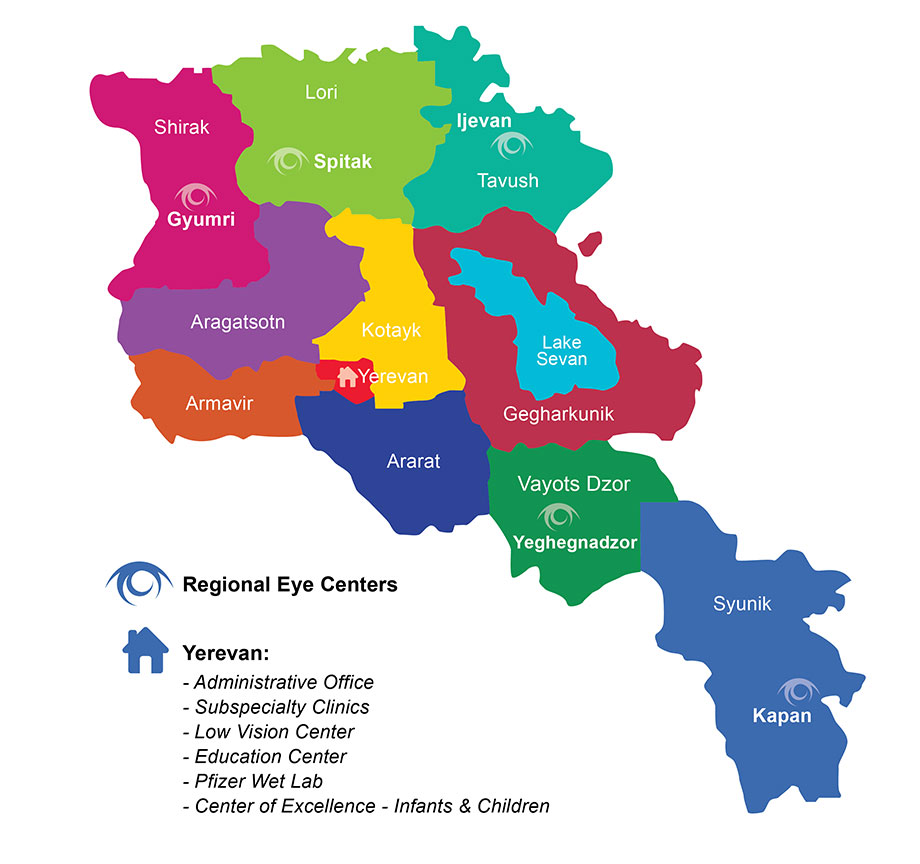 Epidemiology is the study and analysis of the distribution — who, when, how and where they occur — and determinants of health and disease conditions in defined populations. Epidemiological research provides a foundation to address the immediate and long-term needs of patients with visual impairment and eye disease and contributes to the knowledge about the presence, diagnosis, characteristics, and distribution of eye conditions.
Epidemiology is the study and analysis of the distribution — who, when, how and where they occur — and determinants of health and disease conditions in defined populations. Epidemiological research provides a foundation to address the immediate and long-term needs of patients with visual impairment and eye disease and contributes to the knowledge about the presence, diagnosis, characteristics, and distribution of eye conditions.
Epidemiological research provides information on the extent of visual impairment and eye disease in Armenia and other developing countries. This information is essential in determining the causes of eye disease and identifying primary and secondary eye health care needs.
Today there is little information available in Armenia on the prevalence of eye disease in the general population and the impact the disease has on the individual. Additionally, current medical services in Armenia are not equipped to follow-up accurately, or assess regularly, patients with eye disease. Consequently, little is known about the etiologic (cause) factors affecting the occurrence and progression of eye disease.
Epidemiological Research Has Many Functions:
- To study the course of eye diseases and disorders.
- To determine the frequency of eye diseases in specific populations, e.g., age groups, geographical locations.
- To identify the patterns of disease occurrence, e.g., age groups, geographical locations.
- To identify the risk factors for and potential causes of an eye disease.
- To evaluate the effectiveness of preventative measures.
The EyeCare Project’s Contribution to Epidemiological Research in Armenia
 Through its monitoring and evaluation protocols the EyeCare Project has implemented a method to collect data, which contributes to epidemiological research on eye diseases and disorders in Armenia. The Mobile Eye Hospital, the Center of Excellence for the Prevention of Childhood Blindness and the Subspecialty Clinics collect data on all of the patients they screen, approximately 100,000 annually — who, what, when, how, and where — which yields a broad database for eye disease and a comparison among age groups, marzes and other demographic factors. This data is accumulated, analyzed and interpreted and shared with the Armenian government, hospitals and clinics throughout Armenia.
Through its monitoring and evaluation protocols the EyeCare Project has implemented a method to collect data, which contributes to epidemiological research on eye diseases and disorders in Armenia. The Mobile Eye Hospital, the Center of Excellence for the Prevention of Childhood Blindness and the Subspecialty Clinics collect data on all of the patients they screen, approximately 100,000 annually — who, what, when, how, and where — which yields a broad database for eye disease and a comparison among age groups, marzes and other demographic factors. This data is accumulated, analyzed and interpreted and shared with the Armenian government, hospitals and clinics throughout Armenia.
The goal of the Project’s epidemiological research is to limit disease, disease progression, injury and blindness throughout Armenia with early diagnosis and intervention. With the measurement of the occurrence of specific eye diseases in Armenia we are able to intervene early and preserve eyesight.
The most important data measurement determines prevalence — one of the two basic measurements of disease frequency in epidemiology.
- Prevalence. Measures the number of existing cases, both new cases and cases that have been diagnosed in the past, in a population at any given point in time. By using these measures epidemiologists can determine the frequency of disease within populations, and compare differences in disease risk among populations.
- Incidence. The number of new cases of disease in a population occurring over a defined period of time.
Data-Driven Research. The Project’s research is data-driven and relies on a systematic and unbiased approach to the collection, analysis, and interpretation of data. Basic epidemiologic methods rely on careful observation and use of valid comparison groups to assess whether what was observed, such as the number of cases of eye disease in a particular region during a particular time period differs from what might be expected or diverges from a different region or age group. Data is used for the following:
- To plan and evaluate strategies to prevent illness and as a guide to the management of patients in whom disease has already developed.
- To determine what factors are associated with diseases (risk factors), and what factors may protect people or animals against disease (protective factors).
- To study how often diseases occur in different groups of people and why.
- To identify the causes and other factors — determinants — that influence the occurrence of health-related events such as diseases, syndromes, and injuries.
Research and Age Distribution
 Most leading causes of visual impairment are age-related and therefore the health care implications of an increasing prevalence of eye disease in the elderly are significant. Moreover, almost all of the major eye diseases and disorders affecting the elderly are progressive, and if untreated will cause visual impairment and blindness. This is further compounded by the symptoms found in glaucoma and AMD, where people will only present for investigation and treatment if they know they are at risk.
Most leading causes of visual impairment are age-related and therefore the health care implications of an increasing prevalence of eye disease in the elderly are significant. Moreover, almost all of the major eye diseases and disorders affecting the elderly are progressive, and if untreated will cause visual impairment and blindness. This is further compounded by the symptoms found in glaucoma and AMD, where people will only present for investigation and treatment if they know they are at risk.
To minimize the extent of eye disease in adult life, early identification and treatment are essential and pose a challenge for health care professionals. The aim is to determine the extent of eye disease within the community, which involves investigating the prevalence, determinants and trends of the major eye disorders, and assessing current eye services. Since the biggest challenge facing Armenians is access to care, assessing available eye services is critical.
Once the information is available, resources can be allocated to accessible eye care services, to ensure a substantial reduction in the number of people suffering from vision loss and visual impairment. As well, education programs in communities aimed at the prevention of eye disease.
Research has resulted in new treatments and therapies for a number of age-related eye conditions.
The expanding population at risk for eye and vision disease will increasingly demand new and more effective therapies that not only stabilize vision loss but restore it, or even ultimately prevent the onset of these diseases.
- Like the clinical findings and pathology, the epidemiology of a disease is an integral part of its basic description.
- Epidemiological information is used to plan and evaluate strategies to prevent illness and as a guide to the management of patients in whom disease has already developed.
Current EyeCare Project Research
- Prevalence Research. Collect, analyze and interpret data gathered from the Mobile Eye Hospital, Center of Excellence, Subspecialty Clinics and Armenian Schools.
- Clinical Trials. AECP Fellows work with United States companies to conduct clinical trials for new medications. Lilit Voskanyan is currently working on a clinical trial with Glaukos for the treatment of Glaucoma.
- Research Grants. Armenian physicians are currently working on research and educational grants in retina, cataract and glaucoma.
- EyeCare Project Patient Care Programs. The EyeCare Project is implementing two country-wide programs — diabetic retinopathy and children’s eye screening — grades K – 8. A number of studies will be integrated into these programs including prevalence, prevention, public education and the impact of early diagnosis and intervention.







